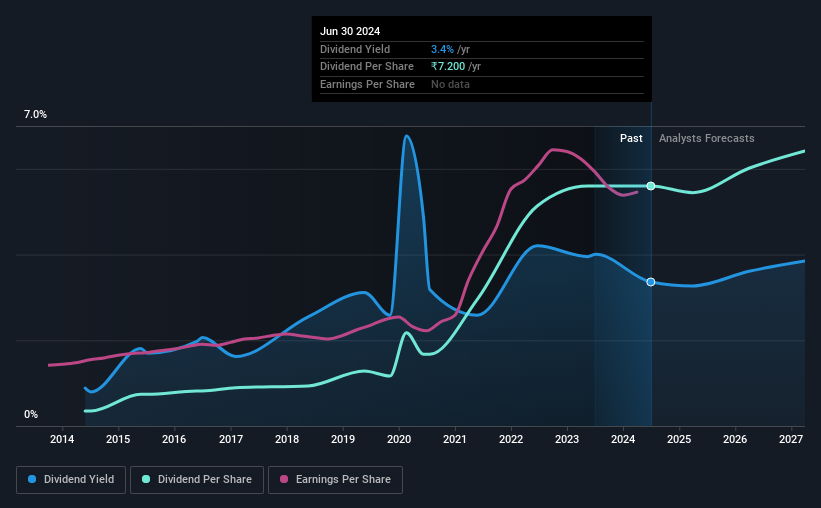- India
- /
- Electronic Equipment and Components
- /
- NSEI:REDINGTON
Redington Limited (NSE:REDINGTON) Passed Our Checks, And It's About To Pay A ₹6.20 Dividend
Some investors rely on dividends for growing their wealth, and if you're one of those dividend sleuths, you might be intrigued to know that Redington Limited (NSE:REDINGTON) is about to go ex-dividend in just four days. The ex-dividend date is usually set to be one business day before the record date which is the cut-off date on which you must be present on the company's books as a shareholder in order to receive the dividend. It is important to be aware of the ex-dividend date because any trade on the stock needs to have been settled on or before the record date. Thus, you can purchase Redington's shares before the 5th of July in order to receive the dividend, which the company will pay on the 29th of August.
The company's next dividend payment will be ₹6.20 per share, on the back of last year when the company paid a total of ₹7.20 to shareholders. Looking at the last 12 months of distributions, Redington has a trailing yield of approximately 3.4% on its current stock price of ₹214.22. If you buy this business for its dividend, you should have an idea of whether Redington's dividend is reliable and sustainable. So we need to check whether the dividend payments are covered, and if earnings are growing.
Check out our latest analysis for Redington
If a company pays out more in dividends than it earned, then the dividend might become unsustainable - hardly an ideal situation. Redington paid out a comfortable 40% of its profit last year. That said, even highly profitable companies sometimes might not generate enough cash to pay the dividend, which is why we should always check if the dividend is covered by cash flow. Dividends consumed 59% of the company's free cash flow last year, which is within a normal range for most dividend-paying organisations.
It's positive to see that Redington's dividend is covered by both profits and cash flow, since this is generally a sign that the dividend is sustainable, and a lower payout ratio usually suggests a greater margin of safety before the dividend gets cut.
Click here to see the company's payout ratio, plus analyst estimates of its future dividends.

Have Earnings And Dividends Been Growing?
Businesses with strong growth prospects usually make the best dividend payers, because it's easier to grow dividends when earnings per share are improving. If business enters a downturn and the dividend is cut, the company could see its value fall precipitously. For this reason, we're glad to see Redington's earnings per share have risen 19% per annum over the last five years. Redington has an average payout ratio which suggests a balance between growing earnings and rewarding shareholders. This is a reasonable combination that could hint at some further dividend increases in the future.
Another key way to measure a company's dividend prospects is by measuring its historical rate of dividend growth. Since the start of our data, 10 years ago, Redington has lifted its dividend by approximately 32% a year on average. It's exciting to see that both earnings and dividends per share have grown rapidly over the past few years.
To Sum It Up
Is Redington an attractive dividend stock, or better left on the shelf? Earnings per share have grown at a nice rate in recent times and over the last year, Redington paid out less than half its earnings and a bit over half its free cash flow. There's a lot to like about Redington, and we would prioritise taking a closer look at it.
While it's tempting to invest in Redington for the dividends alone, you should always be mindful of the risks involved. In terms of investment risks, we've identified 1 warning sign with Redington and understanding them should be part of your investment process.
If you're in the market for strong dividend payers, we recommend checking our selection of top dividend stocks.
New: AI Stock Screener & Alerts
Our new AI Stock Screener scans the market every day to uncover opportunities.
• Dividend Powerhouses (3%+ Yield)
• Undervalued Small Caps with Insider Buying
• High growth Tech and AI Companies
Or build your own from over 50 metrics.
Have feedback on this article? Concerned about the content? Get in touch with us directly. Alternatively, email editorial-team (at) simplywallst.com.
This article by Simply Wall St is general in nature. We provide commentary based on historical data and analyst forecasts only using an unbiased methodology and our articles are not intended to be financial advice. It does not constitute a recommendation to buy or sell any stock, and does not take account of your objectives, or your financial situation. We aim to bring you long-term focused analysis driven by fundamental data. Note that our analysis may not factor in the latest price-sensitive company announcements or qualitative material. Simply Wall St has no position in any stocks mentioned.
Have feedback on this article? Concerned about the content? Get in touch with us directly. Alternatively, email editorial-team@simplywallst.com
About NSEI:REDINGTON
Redington
Distributes information technology, mobility, and other technology products in India, the Middle East, Turkey, Africa, and South Asian countries.
Solid track record with adequate balance sheet and pays a dividend.
Similar Companies
Market Insights
Community Narratives




